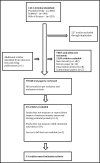The impact of maternal prenatal and postnatal anxiety on children's emotional problems: a systematic review
- PMID: 29948234
- PMCID: PMC6510846
- DOI: 10.1007/s00787-018-1173-5
The impact of maternal prenatal and postnatal anxiety on children's emotional problems: a systematic review
Abstract
Maternal mental health problems during pregnancy and the postnatal period are a major public health issue. Despite evidence that symptoms of both depression and anxiety are common during pregnancy and the postpartum, the impact of maternal anxiety on the child has received relatively less attention than the impact of maternal depression. Furthermore, the evidence base for the direct impact of maternal anxiety during pregnancy and the postpartum on children's emotional outcomes lacks cohesion. The aim of this systematic review is to summarise the empirical evidence regarding the impact of maternal prenatal and postnatal anxiety on children's emotional outcomes. Overall, both maternal prenatal and postnatal anxiety have a small adverse effect on child emotional outcomes. However, the evidence appears stronger for the negative impact of prenatal anxiety. Several methodological weaknesses make conclusions problematic and replication of findings is required to improve the identification of at-risk parents and children with appropriate opportunities for intervention and prevention.
Keywords: Child; Development; Emotion; Maternal anxiety; Perinatal.
Conflict of interest statement
On behalf of all authors, the corresponding author states that there is no conflict of interest.
Figures
References
-
- National Institute for Health and Care Excellence. Prenatal and Postnatal Mental Health: Clinical Management and Service Guidance. NICE; 2014 - PubMed
Publication types
MeSH terms
LinkOut - more resources
Full Text Sources
Other Literature Sources
Medical


